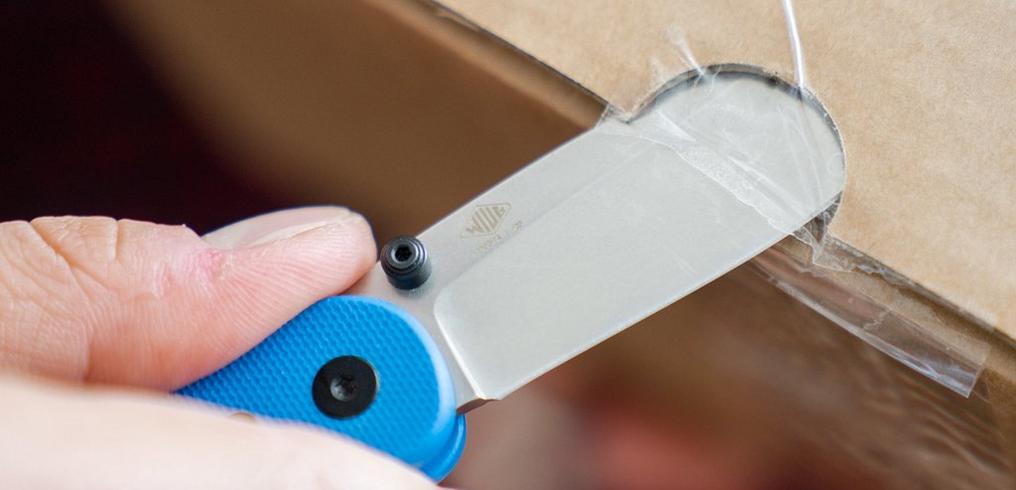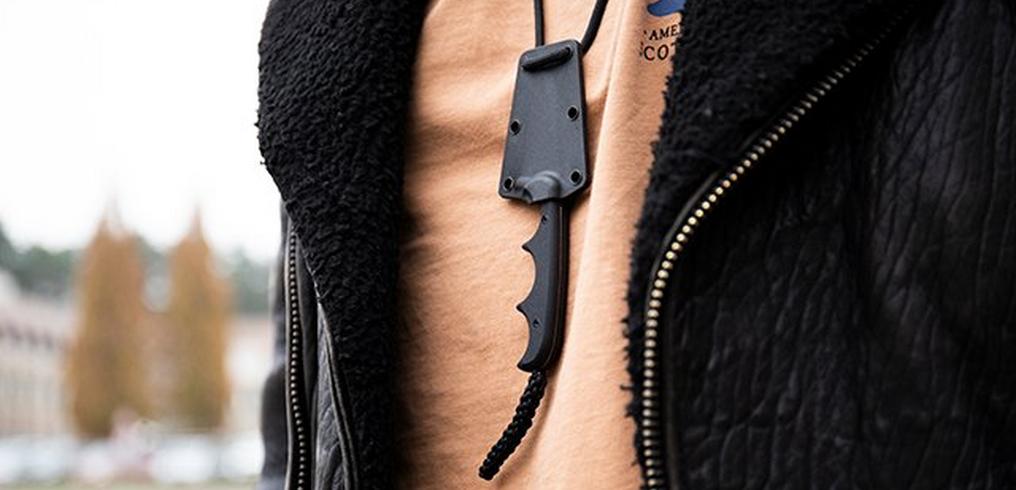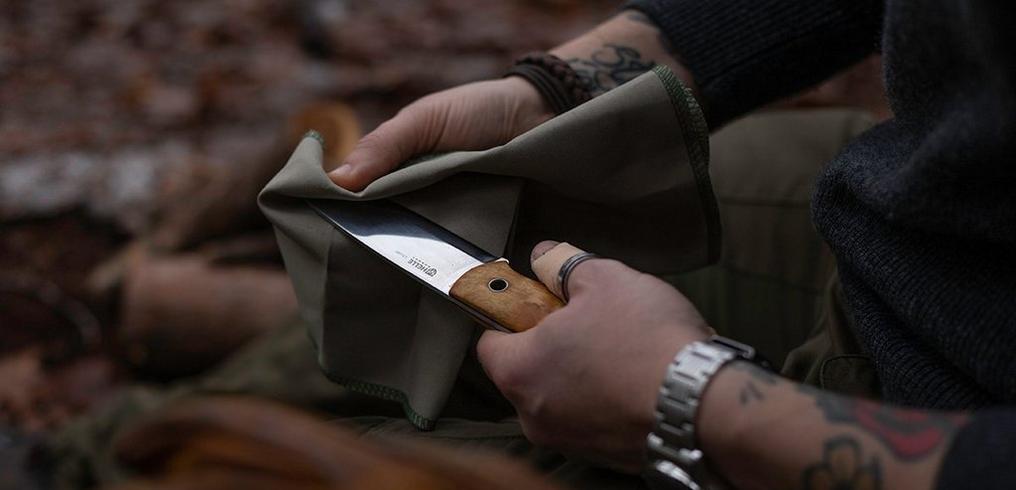Opinel museum and factory visit in France
Opinel is a brand you've probably come across, whether you're a knife fan or not. Opinel knives can be found in any outdoor store or kitchen store. But how did this iconic French brand actually emerge? How did a modest workshop in France grow into a global symbol of craftsmanship? Invited by Opinel, we travelled to Savoie in France to learn more.
Table of contents:
Opinel headquarters
After a short flight from Amsterdam to Geneva, Switzerland, we were picked up for an hour-long drive through the breathtaking French mountain scenery. Our destination: Opinel's headquarters in Chambéry. Here, we were warmly welcomed and immediately immersed in the rich history of the brand. One of the first things we saw was the original display case Opinel used for the Alpine Exhibition in Turn in 1911, when Joseph Opinel was awarded a gold medal by the jury. The display case showed off his famous Opinel Savoie, available in the sizes we still know today. But Opinel did not stop there: the collection also included kitchen knives, table knives, razors, scissors, cheese scoops, pruning knives and corkscrews, all of which quickly became an integral part of the collection.
Musée Opinel and Opinel's history
After dropping off our bags, we drove to the Opinel museum, hidden in the shadow of the French Alps. A large sign with ‘L'Opinel’ along the road reminded us that this is no ordinary knife brand. The museum, located in Saint-Jean-de-Maurienne, covers almost 700 m² and is entirely dedicated to the story of the famous Savoie knife. Here we learned about the brand's most important historical developments.
1872 – Birth of Joseph Opinel
The story begins with Victor-Amédée Opinel, a traveling merchant who learned nail forging and set up a forge near Saint-Jean-de-Maurienne. His son, Daniel, continued the tradition as a blacksmith, beloved by local farmers. Joseph Opinel, Daniel's eldest son, was born in 1872 and showed an early interest in innovation. At 18, he worked in the family workshop and developed a passion for new technologies, even building his own camera. Despite resistance from his father, who preferred traditional craftsmanship to modernity, Joseph perfected a small pocket knife in his spare time: the Opinel.
1897 - The creation of numbers 1 to 12
An innovative man, Joseph Opinel decided to produce the knife in different sizes; suitable for a variety of users and cutting tasks. In 1897, he developed 12 different sizes, numbered from 1 to 12. The smallest knife, No. 1, even had a ring to attach it to the chain of a pocket watch. Production of both No. 1 and No. 11 ceased in 1935. Today, the smallest Opinel knife, No. 2, has a 3.5 cm blade, while the largest knife, No. 12, has a 12 cm blade.
As commercial success continued, Joseph had to produce large quantities. Joseph left his father's forge and built his own factory, where he streamlined production and developed machinery for faster handle manufacturing.
1909 - The crowned hand
In 1565, King Charles IX of France ordered every master knife-maker to place an emblem on their products as a sign of origin and quality. To continue this tradition, Joseph Opinel chose the symbol of the crowned hand in 1909. This symbol, derived from the arms of the city of Saint-Jean-de-Maurienne, represents the blessed hand of St. John the Baptist and commemorates Savoie's duchy. Ever since, all Opinel knives and tools feature this logo. Originally placed horizontally, the logo was later placed vertically on the blade.
1915 - Move to Chambéry
Joseph realised he could not continue to grow his business in the remote village. During World War I, he found a more favourable location on the outskirts of Chambéry, in Cognin. Here he bought an old tannery with a waterfall on the Hyères canal, close to the train station. This strategic location, smack in the middle of the rail and road network, offered great advantages. Using mules and oxen, the factory was moved to Chambéry. After a thorough renovation, Joseph, together with his sons Marcel and Léon, further developed the Opinel brand in 1917.
Chambéry, then a centre of railway work, housed many workmen. According to the stories, Joseph Opinel gave a large group of railway workers a free Opinel knife. This clever action reinforced Opinel's reputation as the knife for the worker and contributed to the brand's status as a reliable, everyday tool.
1955 – Invention of the Virobloc
The original Opinel knife consisted of four parts: the blade, the fixed ring, the rivet and the handle. In 1955 Marcel Opinel introduced the Virobloc system, a rotating ring that locks the blade in the open position. In the 1990s, this system was further developed to also lock the blade in the closed position. Since 2000, the Virobloc system has been standard on all models except Opinel's smallest pocket knives.
1985 – A design icon
The design of the Opinel knife is one of the most successful ever and has hardly changed since its introduction. In 1985, Opinel was recognised by the Victoria and Albert Museum as one of the 100 best-designed items in the world, alongside icons such as the Porsche 911 and the Rolex watch.
2012 - Opinel continues innovating
Even after its many successes, Opinel continues to evolve and innovate. In 2012, the brand took a revolutionary step with the introduction of their first knife with a polymer handle. Whereas previously all handles were made of wood, the polymer material offered new possibilities: it is water-resistant, heat-resistant and ideal for extreme conditions. Moreover, this material enabled a special addition: a built-in whistle in the handle. Although Opinel had been experimenting with this feature for years, it never proved successful with wood.
A closer look at Opinel's factory
After our museum visit, we returned to the factory, located next to Opinel's headquarters. On the way, we passed the world's largest Opinel, proudly displayed on a roundabout in Saint-Jean-de-Maurienne. This famous landmark is a favourite for Tour de France enthusiasts. Opinel has therefore released several special editions of their knives in honour of the Tour de France. The year 2024 is special for Opinel, as the Tour de France will start in Saint-Jean-de-Maurienne, where the museum is also located.
6.5 million knives a year
With all the knowledge we had gained about the history and production of Opinel, it was truly fascinating to visit the factory. This is where the scale on which Opinel operates became really clear. With an annual production of more than 6.5 million knives and a total estimated 315 million knives produced since the brand's inception, it is almost impossible to imagine that this once started as a modest forge.
How the handles are made
For the handles, Opinel uses mainly beech wood, a local type of wood mined in the southern Alps, just an hour's drive from the factory. Beech wood is a popular choice because of its low moisture content and machinability. If the wood contains more than 10% moisture, it can hardly be used on this scale.
Each piece of wood is cut to size for specific knives. Even a few millimetres of deviation can cause problems during the production process. The blocks are then placed in huge wood turning machines, which use a copy template to cut the characteristic shape of the handle from the wood. This ensures every handle is consistent and of good quality.
Despite the fact that Opinel produces millions of knives a year, they still scrutinise every handle to see if there are any flaws in the material. Of course, wood is a natural product so it's never 100% perfect.
Opinel is a very sustainable company, but more on that later. An example of this, however, is the Atelier collection. For this collection, Opinel mainly uses leftover wood from the production of other knives. This series shows a lot of creativity and craftsmanship from the woodworkers, as they come up with different combinations of their own. They also assemble each handle themselves and a huge amount of handwork is involved which makes this collection very special.
How the blades are made
Opinel produces knives with either carbon steel or stainless steel blades. Carbon steel, an alloy of iron and carbon, is robust and retains its sharpness for a long time, but is susceptible to oxidation. To reduce corrosion, at least 10.5% chromium can be added, resulting in stainless steel or ‘inox’. Opinel has been using these two steel types for years. Opinel strives for a hardness of 57 HRC, striking a balance between blade strength and corrosion resistance. The blades enter the warehouse in raw form and are then sharpened in batches.
The blades are sharpened in a special way with grinding wheels produced according to a secret ‘recipe’ especially for Opinel. The blades are ground on the inside of the grinding wheels, not on the outside, giving them a convex grind. This sharpening is more robust than flat or hollow grinding, so an Opinel knife, despite its thin blade, can take quite a beating.
The production of the Virobloc system and assembling the knives
The Virobloc lock is perhaps the most distinctive feature of an Opinel knife, making the brand truly stand out from its competitors. During our tour, we passed by the machine that produces this iconic Virobloc lock. In several meticulous steps, the characteristic ring is formed from a piece of sheet steel. Sadly, but understandably, we were not allowed to cover this process as the techniques used are strictly secret. Just standing next to this machine left an impression on us. Just knowing that all the Virobloc locks we have held in our hands at Knivesandtools have come from this machine, it was very special. It was like standing next to the beating heart of Opinel.
What stood out to us was that the assembly, including sharpening the blades, is mostly done by hand. This is incredibly impressive, considering Opinel produces millions of knives each year. It is here that the Virobloc lock is placed on the pocket knife, transforming the knife into a real Opinel.
Opinel and sustainability
With production of this scale you'd expect there to be drawbacks. Nothing could be further from the truth! Opinel makes the most of each situation and is exceptionally sustainable, a term that is often thrown around nowadays without necessarily always being true. Few knife makers are as dedicated to sustainability as Opinel, where they carefully consider their impact on the environment. Here are some noteworthy examples of their dedication to sustainability:
-
Opinel sources most of their wood from certified companies. 95% of the wood is sourced from French, sustainably managed forests.
-
50% of Opinel's suppliers are located in the Auvergne-Rhône-Alpes region, and 80% in France, which helps minimise transport pollution.
-
All wood chips generated in the production of handles are burned. The resulting heat is used to provide heating for workshops and offices.
-
Opinel works with specialised external companies to ensure they meet all legal requirements. This includes regular measurement of air and water discharges, dust emissions, noise, energy consumption and waste management.
-
As mentioned earlier, the handles in the Atelier collection are made from leftover wood, which means Opinel makes the best use of resources and minimises waste.
-
For years, Opinel has used cardboard packaging with eco-friendly ink. The design of the packaging reduces the amount of cardboard needed, and products are sold in packs of 6 or 12, rather than separately.
-
Since 2016, Opinel has partnered with Pollinium, which has installed four beehives at their site in Chambéry. This collaboration helps Opinel understand the importance of bees for biodiversity and is a tribute to Joseph Opinel, who was a passionate beekeeper.
An eye-opener
Our visit to the Opinel factory was a true eye-opener, giving us a deeper understanding of the scale at which Opinel produces their iconic knives. In a world where mass production often supplies cheap items from Asia, it is striking how special companies like Opinel are, with their rich history and craftsmanship. An Opinel knife offers real value for money and belongs in every knife lover's collection. Do you already own an Opinel knife? The museum in Saint-Jean-de-Maurienne is not to be missed!




























?%24center=center&%24poi=poi&%24product-image%24=&fmt=auto&h=490&poi=%7B%24this.metadata.pointOfInterest.x%7D%2C%7B%24this.metadata.pointOfInterest.y%7D%2C%7B%24this.metadata.pointOfInterest.w%7D%2C%7B%24this.metadata.pointOfInterest.h%7D&scaleFit=%7B%28%24this.metadata.pointOfInterest%29%3F%24poi%3A%24center%7D&sm=c&w=1016)

?%24center=center&%24poi=poi&%24product-image%24=&fmt=auto&h=490&poi=%7B%24this.metadata.pointOfInterest.x%7D%2C%7B%24this.metadata.pointOfInterest.y%7D%2C%7B%24this.metadata.pointOfInterest.w%7D%2C%7B%24this.metadata.pointOfInterest.h%7D&scaleFit=%7B%28%24this.metadata.pointOfInterest%29%3F%24poi%3A%24center%7D&sm=c&w=1016)


